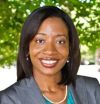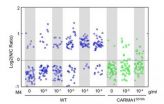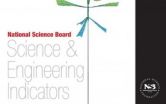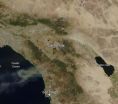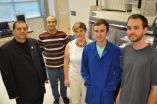(Press-News.org) HOUSTON – (May 15, 2014) – Children of fathers who are in technical occupations are more likely to have an autism spectrum disorder, according to researchers at The University of Texas Health Science Center at Houston (UTHealth).
The findings will be presented Friday at the International Meeting for Autism Research in Atlanta.
During participation in the LoneStar LEND program, first author Aisha S. Dickerson, Ph.D., a researcher at UTHealth's Center for Clinical and Translational Sciences, used the United States government's Standard Occupational Classification system. Parents were divided into those who had more non-people-oriented jobs (technical) or more people-oriented jobs (non-technical).
Fathers who worked in engineering were two times as likely to have a child with an autism spectrum disorder (ASD). Those who worked in finance were four times more likely and those who worked in health care occupations were six times more likely to have a child on the autism spectrum.
There was no association with a mother's occupation. However, children who had both parents in technical fields were at a higher risk of having a more severe form of autism.
"Parental occupation could be indicative of autistic-like behaviors and preferences and serve as another factor in a clinician's diagnosis of a child with suspected autism. Medical students can be taught that this is one of the things to consider," Dickerson said.
Senior author of the paper, "Role of Parental Occupation in Autism Spectrum Disorder Diagnosis and Severity," is Pauline A. Filipek, M.D., professor and director of the Autism Center at the UTHealth Medical School's Children's Learning Institute. UTHealth co-authors include Deborah Pearson, Ph.D., professor of psychiatry and behavioral sciences; Katherine Loveland, Ph.D., professor of psychiatry and behavioral sciences and professor at The University of Texas Graduate School of Biomedical Sciences at Houston; and Mohammad Hossein Rahbar, Ph.D., director of the Division of Clinical and Translational Sciences in the Department of Internal Medicine and professor of epidemiology and biostatics in the UTHealth School of Public Health.
INFORMATION:
UTHealth research: Children of parents in technical jobs at higher risk for autism
2014-05-15
ELSE PRESS RELEASES FROM THIS DATE:
B cells produce antibodies 'when danger calls, but not when it whispers'
2014-05-15
The immune system's B cells protect us from disease by producing antibodies, or "smart bullets," that specifically target invaders such as pathogens and viruses while leaving harmless molecules alone. But how do B cells determine whether a threat is real and whether to start producing these weapons?
An international team of life scientists shows in the May 16 issue of the journal Science how and why these cells respond only to true threats.
"It is critical for B cells to respond either fully or not at all. Anything in between causes disease," said the study's senior ...
Researchers show emissions from forests influence very first stage of cloud formation
2014-05-15
PITTSBURGH—Clouds play a critical role in Earth's climate. Clouds also are the largest source of uncertainty in present climate models, according to the latest report of the Intergovernmental Panel on Climate Change. Much of the uncertainty surrounding clouds' effect on climate stems from the complexity of cloud formation.
New research from scientists at the CLOUD (Cosmics Leaving OUtdoor Droplets) experiment at CERN, including Carnegie Mellon University's Neil Donahue, sheds light on new-particle formation — the very first step of cloud formation and a critical component ...
New data show how states are doing in science
2014-05-15
The newly updated, online, interactive state data tool allows policymakers, educators and other users to discern trends in education, science and research in each of the 50 states. This free resource supplements the state data in the 2014 Science and Engineering Indicators report, the premier source of information and analysis of the nation's position in science and engineering education and research. The biennial report is published by the National Science Board, the policy making body of the National Science Foundation (NSF).
The tool features 59 state indicators of ...
UH Case Medical Center neurosurgeon uses depth electrodes for speech mapping
2014-05-15
CLEVELAND -- At the 2014 American Association of Neurological Surgeons Annual Meeting, neurosurgical researchers from University Hospitals (UH) Case Medical Center presented results from a small study looking at deep brain electrode implantation as a possible alternative to the traditional WADA test used prior to epilepsy surgery.
The WADA test is considered the gold standard for identifying the side of the brain for speech dominance. In the WADA test, doctors put one half of a patient's brain to sleep for a few minutes using medication and then have the patient read ...
Study: Targeted funding can help address inequities in early child care programs
2014-05-15
CORVALLIS, Ore. – The quality of early child care and education programs is influenced both by funding and by the characteristics of the communities in which the programs operate, new research from Oregon State University shows.
The findings indicate that law- and policy-makers may need to consider the demographics of communities when making funding decisions about early childhood programs, said Bridget Hatfield, an assistant professor in OSU's College of Public Health and Human Sciences.
That's especially important now because many states, including Oregon, are adopting ...
Fires in San Diego County blazing
2014-05-15
The single fire that ignited and split into nine separate fires still blazes in Southern California today. Firefighters are hoping for a break today (Thursday, May 15, 2014) but it doesn't look like luck may be on their side. Conditions continue to be bone dry with unseasonal heat (98-106 degrees) and the Santa Ana winds are kicking up and allowing these fires to easy jump fire lines. This particular fire started on Wednesday as a single fire and within a day is now nine separate fires which have burned close to 10,000 acres. These fires are threatening more than just ...
Giant telescope tackles orbit and size of exoplanet
2014-05-15
Using one of the world's largest telescopes, a Lawrence Livermore team and international collaborators have tracked the orbit of a planet at least four times the size of Jupiter.
The scientists were able to identify the orbit of the exoplanet, Beta Pictoris b, which sits 63 light years from our solar system, by using the Gemini Planet Imager's (GPI) next-generation, high-contrast adaptive optics (AO) system. This approach is sometimes referred to as extreme AO.
The Gemini Planet Imager snapped an amazingly clear and bright image of the gas giant Beta Pictoris b after ...
Detailed studies reveal how key cancer-fighting protein is held in check
2014-05-15
St. Jude Children's Research Hospital scientists have mapped the structural details of how p53 attaches to its regulatory protein, called BCL-xL, in the cell. The protein p53 is a key activator of the cell's protective machinery against genetic damage, such as the mutations that drive cancer cells' explosive growth.
The detailed understanding of how these two molecular puzzle pieces fit together will help scientists design drugs that release p53 in cancer cells, triggering their suicide, called apoptosis.
The findings appear in the current online journal Nature Structural ...
Researchers examine intersection of aging, chronic disease
2014-05-15
A new collection of articles appearing in The Journals of Gerontology, Series A: Biological Sciences and Medical Sciences examine how the basic biology of aging drives chronic disease. Together, they highlight the value of the emerging field of geroscience, which uses an integrated approach to the study of diseases and disability associated with growing older.
Geroscience seeks to bridge the divide between studies of aging and studies of chronic disease, with the hope of understanding their complex relationship and pointing the way to novel interventions for disease, ...
Silly Putty material inspires better batteries
2014-05-15
RIVERSIDE, Calif. (http://www.ucr.edu) — Using a material found in Silly Putty and surgical tubing, a group of researchers at the University of California, Riverside Bourns College of Engineering have developed a new way to make lithium-ion batteries that will last three times longer between charges compared to the current industry standard.
The team created silicon dioxide (SiO2) nanotube anodes for lithium-ion batteries and found they had over three times as much energy storage capacity as the carbon-based anodes currently being used. This has significant implications ...
